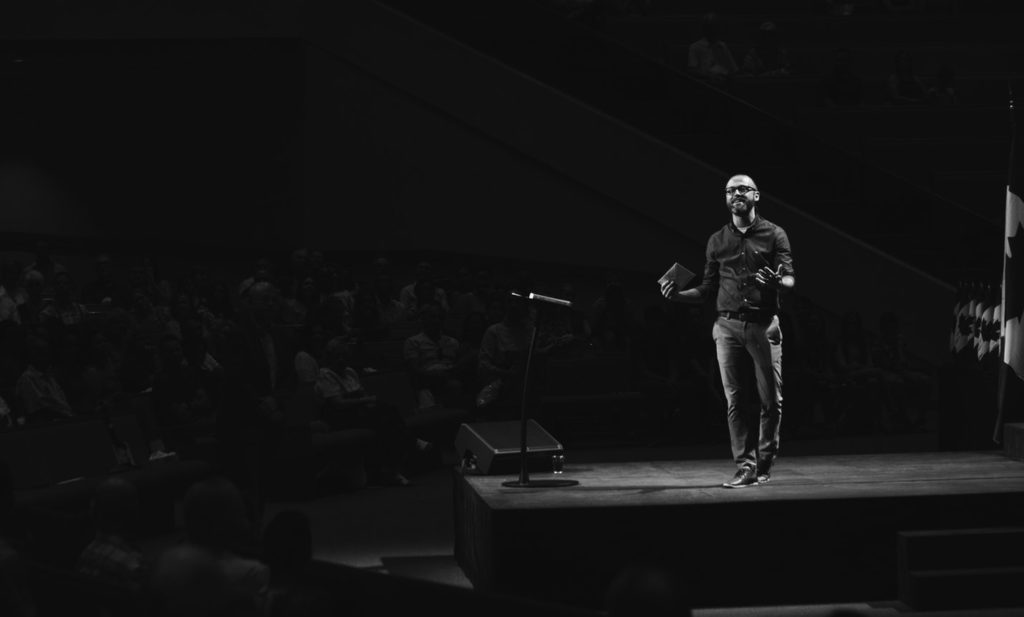In this Article...quick links
- How to stand and speak behind a lectern
- How do I hold a microphone when presenting?
- Should I move when I’m presenting at a Conference on stage?
- How to engage the audience if the lights are shining into my eyes
- What should I wear when I am presenting at a conference?
- How to use notes when presenting at a conference on stage
- What should I do with my hands when presenting on stage?
You’ve probably been to one of those business (industry) conferences where the speaker is cowering behind the lectern, fidgeting nervously on stage, or even struggling to read their speech notes. When presenting at a business or industry conference, projecting confidence and authority is crucial for establishing initial credibility, for maintaining the attention of the audience and for ‘owning the stage. You may have fantastic information and insights to share but your message has every chance of getting lost if you can’t project the professional presentation image people expect. What you need are some presentation tips for business conferences.
Our expert presentation tips for conferences provide you with small, but significant, techniques which will help you get your message across in a credible and impactful way. Let’s get started!
How to stand and speak behind a lectern
A lectern may be a ubiquitous piece of stage furniture at business conferences but for most of us, it can be a physical and symbolic barrier that hinders connection to the audience and takes away from our stage presence. When in doubt, say no to a lectern for your conference presentation.
For one, the lectern could be extremely tall – there’s the possibility it could hide you from the audience altogether. Secondly, it traps you in one place on the stage, which can further hamper your interaction with the audience.
Two important presentation tips for business conferences, if using a lectern is unavoidable, are 1) measure the lectern beforehand and request a platform if you need it, and 2) ask for a microphone that detaches so you can still walk around (and, if that isn’t available, stand tall and resist the urge to lean over when speaking). Remember to bend the microphone to the right angle for your height before you get on stage so you can avoid any awkward shuffling at the beginning of your presentation.
How do I hold a microphone when presenting?
If your audience can’t hear you, nothing else matters. Skipping sound checks prior to your business conference is taking a big risk. Stay about a clenched fist away to be heard properly. To avoid the sound of huffing and puffing into the mic hold the ball of the microphone below your mouth and pointed toward your nose. That way the air travels over the mike and not directly into it. An alternative is to touch the ball to your chin and keep it there. Even when you move your head from one direction to the other, it’s best to stay at that distance to maintain a consistent sound level.
As far as possible, use a clothing mic so you can move about the stage and freely use gestures for maximum impact. When you’re using a clothing mic, wear appropriate clothing. You’ll need to clip it near to your neck, so jacket and shirt collars work great.
Remember: if you start to hear feedback, move closer to the mic, not further away. If the mic isn’t picking up a strong signal from you, it will start picking up other noises and that’s something you want to avoid.
Should I move when I’m presenting at a Conference on stage?
Pacing around or shuffling side to side will show your nerves, while standing still can disconnect you from the audience.
Dynamic movements on stage are a simple way to take your presentation to the next level.
Speaking at a business conference is like the theatre – when you move with purpose, it elevates what you’re saying. You can get your best conference presentation techniques from watching professionals at work. When Steve Jobs unveiled his new Apple products, he understood the importance of this. Once, when speaking about how the new MacBook Air was so thin it could fit into an envelope, Jobs walked right across the side of the stage, picked up an envelope and took out that very MacBook to wild cheers.
One of the more important presentation tips for business conferences is that moving with deliberate purpose in between key messages will make your stage presence more engaging and impactful for the audience. To do this effectively you should analyse the stage before you present. Map out your talk within its parameters, taking into account the layout of the lighting and other equipment that could obstruct your ability to move.
How to engage the audience if the lights are shining into my eyes
Eye connection is the best way to build (non-verbal) rapport with your audience with your audience and to project that you’re confident and in control, but do it wrong and your audience will see right through you and to your hesitation or nerves.
With a large room or auditorium break the audience into 4 or 6 equal areas (ensuring you include those at the sides and back of the room) and connect equally with each of the areas. But remember to keep this natural. This will help you avoid your eyes skimming left and right or going around in a fixed circle which could make you look contrived or, worse, panicked.
Your eyes really convey the emotions behind your message so even if you can’t make direct eye contact, whether that’s due to bright lighting or the size of the room, aim to look in the general area of their faces, not at their bodies and certainly not over their heads.
What should I wear when I am presenting at a conference?
What to wear for a conference presentation is often a hard decision to make. Consider the surroundings you’ll be presenting in and choose colours and patterns accordingly. For example, if you’re presenting in front of a big blue backdrop or screen, don’t wear blue, as you’ll blend into the background. If your presentation is going to be videoed, solid colours are safest as clothing with thin stripes or tiny dots creates a wavy pattern known as the moire effect.
Ensure you choose something comfortable, which allows you to move. Don’t wear rattly jewellery, which may get picked up by the mic. Shiny and chunky jewellery could also reflect off too much light. Avoid wearing a lanyard as it is distracting and presents you as ‘other’ to your audience. First impressions count!
How to use notes when presenting at a conference on stage
Even the best presenters get nervous. Notes are a good failsafe but should only be a quick reminder of your key messages, rather than a narration of your entire presentation. Remember that you will struggle to read normal 12pt text at an arm’s length away, especially if the lights are dimmed for a PowerPoint presentation. One of the key presentation tips for business conferences is to make sure your notes are typed in an easy-to-read, large font size (16+). Make sure that they are condensed into bullet points and that they are double-spaced. Someone squinting at their notes to read them is a recipe for disaster for the presenter and the audience.
What should I do with my hands when presenting on stage?
One question that crops up all the time when people are speaking at business conferences is, “What should I do with my hands when presenting on stage?” Vanessa Van Edwards, a body language trainer, studied famous TED talks and found that the most popular speakers were the ones who used their hands the most.
Do what comes naturally and keep your hand movements descriptive. Your gestures should remain in the ‘strike zone’, the area from your shoulder to the top of your hips.
Of course, there are times when it doesn’t feel natural or appropriate to gesture. That’s why it’s important to learn your own ‘neutral hand position’ – the place your hands go to rest. For most people, a confident looking neutral position is where the hands are resting together at about waist level. This keeps your hands part of the picture but not distracting or nervous looking.
Most people should avoid ‘Dead Hands’ (arms and hands hanging down at the sides of the body), Hidden Hands (hands behind the body) and Fig Leaf Hands (I don’t think that needs an explanation!) as these make presenters look stiff, awkward or timid.
Test out expressive gestures and open postures beforehand and, when you don’t know what to do with your hands, you can fall back on your neutral position in a relaxed, confident manner.
Regardless of how experienced you are, how you present yourself is almost as important as the presentation itself. Use these tips to become a stronger, more confident business conference presenter.
Related reading: Presenting at a conference for the first time
Are there any business conference presenting questions you have? Leave us a reply below and we’ll do our best to answer them in our upcoming blogs!
To find out more, click on one of the buttons below:

Belinda is the Co-Founder and Managing Director of SecondNature International. With a determination to drive a paradigm shift in the delivery of presentation skills training both In-Person and Online, she is a strong advocate of a more personal and sustainable presentation skills training methodology.
Belinda believes that people don’t have to change who they are to be the presenter they want to be. So she developed a coaching approach that harnesses people’s unique personality to build their own authentic presentation style and personal brand.
She has helped to transform the presentation skills of people around the world in an A-Z of organisations including Amazon, BBC, Brother, BT, CocaCola, DHL, EE, ESRI, IpsosMORI, Heineken, MARS Inc., Moody’s, Moonpig, Nationwide, Pfizer, Publicis Groupe, Roche, Savills, Triumph and Walmart – to name just a few.


